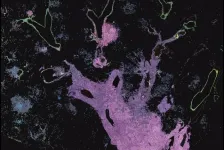(Press-News.org) DURHAM, N.C. – You know that package warning that oral birth control won’t prevent STIs? Well in the case of gonorrhea, the sexually transmitted bacterium that causes the disease can use those hormones to help it resist antibiotic attacks.
Like many bacteria, this bug, Neisseria gonorrhoeae, is equipped with pumps to push the killing chemicals out of its cells. But what’s unique, according to a Duke and Emory study online this week in Nature Communications, is that the hormones of the human urogenital tract actually allow gonorrhea to make and use more of these pumps to fight intrinsic antimicrobials and prescribed antibiotics.
The researchers uncovered the trick while examining a transcription factor – a protein that binds to specific sites on the bacterium’s DNA and slows production of the efflux pumps that protect it.
Led by Duke graduate student Grace Hooks and her mentor, Biochemistry chair Richard Brennan, Ph.D., the study used a variety of approaches to characterize the shape and function of the transcription factor.
What they found is that, unfortunately, this transcription factor, called MtrR, has an affinity for binding to the hormonal steroids progesterone, estrogen and testosterone and the synthetic hormone ethinyl estradiol. When it binds to a hormone, the transcription factor becomes less effective at suppressing the production of bacterial pumps.
Hooks said the bacterium appears to be able to sense its hormonal environment and waits for the opportune time in the female’s menstrual cycle to ramp up its colonization.
Estrogen rises dramatically in the week before ovulation, and progesterone peaks in the two weeks between ovulation and menstruation. These fluctuations are thought to suppress the immune system, giving sperm and eggs a window of opportunity to survive in the urogenital tract, but that same window also creates a vulnerability to this infection.
“It's kind of utilizing this sensory system to gauge where it is in this cycle and when it can best colonize,” Hooks said. “It can only survive in the human host, it can't survive outside. So, it has to really be good at sensing where it is and when’s the best time for colonizing.”
The transcription factor MtrR also helps signal the bacterium to protect itself against reactive oxygen species. “What this one protein does is a dual system to protect Neisseria gonorrhea,” Brennan said.
Gonorrhea has been with humans far longer than there have been antibiotics, appearing in texts as ancient as 2600 BC and making famous appearances in Julius Caesar’s Roman legions and the Crimean war.
Ancient or not, the Centers for Disease Control considers gonorrhea an urgent public health threat, because it is now resistant to every antibiotic except for one, ceftriaxone. But strains resistant to this antibiotic have been identified recently in Europe and Asia.
Known historically and colloquially as ‘the clap,’ untreated gonorrhea in women can lead to pelvic inflammatory disease and infertility. It may also be passed from mother to infant during childbirth.
While the infection is more obvious in men, it is less dramatic, as men don’t experience the wider hormonal shifts, nor is their urogenital tract as complicated or deep as a woman’s, Hooks said. But men still carry all the same hormones that the transcription factor latches onto, she added.
And, of course, the bacteria must thrive in both men and women to be a successful STI. “Neisseria gonorrhoeae is an obligate human pathogen,” Brennan said. “We don’t know where it is the rest of the time.”
When Hooks presented some of her data in a laboratory meeting, fellow graduate student Emily Cannistraci from the next-door Schumacher laboratory asked if the synthetic hormone ethinyl estradiol, which is found in many oral contraceptives for women, would have a similar effect. Hooks checked, and it certainly did.
The takeaway is not only the package warning that oral birth control won’t prevent STIs, but in this case, it might even make them worse.
This research was supported by the National Institutes of Health (R35GM130290, R05 AI048593, R01 AI021150), the US Department of Veterans Affairs and the U.S. Department of Energy.
CITATION: “Hormonal Steroids Induce Multidrug Resistance and Stress Response Genes in Neisseria gonorrhoeae by Binding to MtrR,” Grace M. Hooks, Julio C. Ayala, Concerta L. Holley, Vijaya Dhulipala, Grace A. Beggs, John R. Perfect, Maria A. Schumacher, William M. Shafer, Richard G. Brennan. Nature Communications, Online Feb. 7, 2024. DOI: 10.1038/s41467-024-45195-1
END
Sex hormones help gonorrhea fight off antimicrobials and antibiotics
Notorious infection monitors the environment and waits for its opportunity
2024-02-08
ELSE PRESS RELEASES FROM THIS DATE:
45 finalists named for the 2024 Hertz Fellowships
2024-02-08
The Fannie and John Hertz Foundation today announced 45 finalists for the 2024 Hertz Fellowships in applied science, mathematics and engineering.
Selected from more than 860 applicants and representing 21 universities, the finalists advance to a culminating round of interviews for one of the most competitive and coveted doctoral fellowships in the nation. The 2024 class of Hertz Fellows will be announced in May.
Since 1963, the Hertz Foundation has granted fellowships empowering the nation’s most promising young ...
How one type of lung cancer can transform into another
2024-02-08
Lung tumors called adenocarcinomas sometimes respond to initially effective treatments by transforming into a much more aggressive small cell lung cancer (SCLC) that spreads rapidly and has few options for treatment. Researchers at Weill Cornell Medicine have developed a mouse model that illuminates this problematic process, known as histological transformation. The findings advance the understanding of how mutated genes can trigger cancer evolution and suggest targets for more effective treatments.
The researchers, whose results were published ...
Results from South Pole Telescope’s new camera emerge
2024-02-08
Argonne is part of a multi-institutional effort to survey the sky for clues about the origins and nature of our universe.
For more than five years, scientists at the South Pole Telescope in Antarctica have been observing the sky with an upgraded camera. The extended gaze toward the cosmos is picking up remnant light from the universe’s early formation. Now researchers have analyzed an initial batch of data, publishing details in the journal Physical Review D. The results from this limited dataset hint at even more powerful future insights about the nature of our universe.
The telescope at the Amundsen-Scott South Pole Station, which is operated by the National ...
Rosenthal Department of Management established at McCombs School of Business
2024-02-08
AUSTIN, Texas — The Management Department in the McCombs School of Business at The University of Texas at Austin has long been recognized as a powerhouse for research excellence and teaching innovation. Now, it holds a new distinction. It is the first academic department in the business school to be named as the result of a generous gift.
The newly named Rozanne and Billy Rosenthal Department of Management has been made possible by a $25 million gift from two married Longhorns, Rozanne Rosenthal, B.S. ’74, and Billy Rosenthal, BBA ’72. ...
Professor of Finance named ECGI Fellow
2024-02-08
AUSTIN, Texas -- In recognition of her research and scholarship, Laura Starks, a professor of finance at The University of Texas at Austin, was recently named a fellow of the European Corporate Governance Institute (ECGI). She is among eight new fellows selected from academia in Europe and the United States. ECGI, founded in 2002, is an international scientific nonprofit association that serves as a forum on corporate governance among academics, legislators, and practitioners.
Starks is the George Kozmetsky Centennial University Distinguished Chair in the McCombs School of ...
NJIT researchers unveil method to detect 'forever chemicals' in under 3 minutes
2024-02-08
PFAS have earned the name “forever chemicals” with good reason — the man-made compounds, which can take thousands of years to degrade and are found in everything from grease-resistant food packaging to water-repellent clothing, have made their way into nearly half the U.S. tap water supply.
Now, in a study featured in Elsevier’s Journal of Hazardous Materials, New Jersey Institute of Technology chemists have demonstrated a new lab-based method to detect traces of PFAS from food packaging material, water and soil samples in just three minutes or less.
Researchers say their approach could ...
Exploring new futures in space: a revolutionary integration of neuroscience, quantum physics, and space exploration
2024-02-08
February 8, 2024, Mountain View, CA — The SETI Institute, leading humanity's quest to understand the origins and prevalence of life and intelligence in the universe and share that knowledge with the world, is pioneering innovative approaches to understanding our place in the cosmos. The SETI Institute is proud to support a groundbreaking project from London-based filmmaker and SETI Institute Designer of Experiences Dr. Nelly Ben Hayoun-Stépanian that combines insights from intergenerational trauma, neuroscience, quantum physics, and ...
Technique could improve the sensitivity of quantum sensing devices
2024-02-08
In quantum sensing, atomic-scale quantum systems are used to measure electromagnetic fields, as well as properties like rotation, acceleration, and distance, far more precisely than classical sensors can. The technology could enable devices that image the brain with unprecedented detail, for example, or air traffic control systems with precise positioning accuracy.
As many real-world quantum sensing devices are emerging, one promising direction is the use of microscopic defects inside diamonds to create “qubits” that can be used for quantum sensing. Qubits are the building blocks of quantum ...
New process allows full recovery of starting materials from tough polymer composites
2024-02-08
In a win for chemistry, inventors at the Department of Energy’s Oak Ridge National Laboratory have designed a closed-loop path for synthesizing an exceptionally tough carbon-fiber-reinforced polymer, or CFRP, and later recovering all of its starting materials.
A lightweight, strong and tough composite material, CFRP is useful for reducing weight and increasing fuel efficiency of automobiles, airplanes and spacecraft. However, conventional CFRPs are difficult to recycle. Most have been single-use materials, so their carbon footprint is significant. By contrast, ORNL’s closed-loop ...
Notre Dame joins consortium to support responsible artificial intelligence
2024-02-08
Extraordinary technological innovations have driven an expansion in artificial intelligence (AI) use. At the same time, they have brought little-understood risks to every sector of the economy.
Now, as part of a new consortium, University of Notre Dame researchers will help establish the advanced measurement techniques required to identify the risks associated with current AI systems and to develop new systems that are safer and more trustworthy.
The consortium, called the Artificial Intelligence Safety Institute Consortium (AISIC), was formed by the National Institute of Standards and Technology, an agency of the U.S. Department of Commerce that works to develop standards for ...
LAST 30 PRESS RELEASES:
Why nail-biting, procrastination and other self-sabotaging behaviors are rooted in survival instincts
Regional variations in mechanical properties of porcine leptomeninges
Artificial empathy in therapy and healthcare: advancements in interpersonal interaction technologies
Why some brains switch gears more efficiently than others
UVA’s Jundong Li wins ICDM’S 2025 Tao Li Award for data mining, machine learning
UVA’s low-power, high-performance computer power player Mircea Stan earns National Academy of Inventors fellowship
Not playing by the rules: USU researcher explores filamentous algae dynamics in rivers
Do our body clocks influence our risk of dementia?
Anthropologists offer new evidence of bipedalism in long-debated fossil discovery
Safer receipt paper from wood
Dosage-sensitive genes suggest no whole-genome duplications in ancestral angiosperm
First ancient human herpesvirus genomes document their deep history with humans
Why Some Bacteria Survive Antibiotics and How to Stop Them - New study reveals that bacteria can survive antibiotic treatment through two fundamentally different “shutdown modes”
UCLA study links scar healing to dangerous placenta condition
CHANGE-seq-BE finds off-target changes in the genome from base editors
The Journal of Nuclear Medicine Ahead-of-Print Tip Sheet: January 2, 2026
Delayed or absent first dose of measles, mumps, and rubella vaccination
Trends in US preterm birth rates by household income and race and ethnicity
Study identifies potential biomarker linked to progression and brain inflammation in multiple sclerosis
Many mothers in Norway do not show up for postnatal check-ups
Researchers want to find out why quick clay is so unstable
Superradiant spins show teamwork at the quantum scale
Cleveland Clinic Research links tumor bacteria to immunotherapy resistance in head and neck cancer
First Editorial of 2026: Resisting AI slop
Joint ground- and space-based observations reveal Saturn-mass rogue planet
Inheritable genetic variant offers protection against blood cancer risk and progression
Pigs settled Pacific islands alongside early human voyagers
A Coral reef’s daily pulse reshapes microbes in surrounding waters
EAST Tokamak experiments exceed plasma density limit, offering new approach to fusion ignition
Groundbreaking discovery reveals Africa’s oldest cremation pyre and complex ritual practices
[Press-News.org] Sex hormones help gonorrhea fight off antimicrobials and antibioticsNotorious infection monitors the environment and waits for its opportunity






